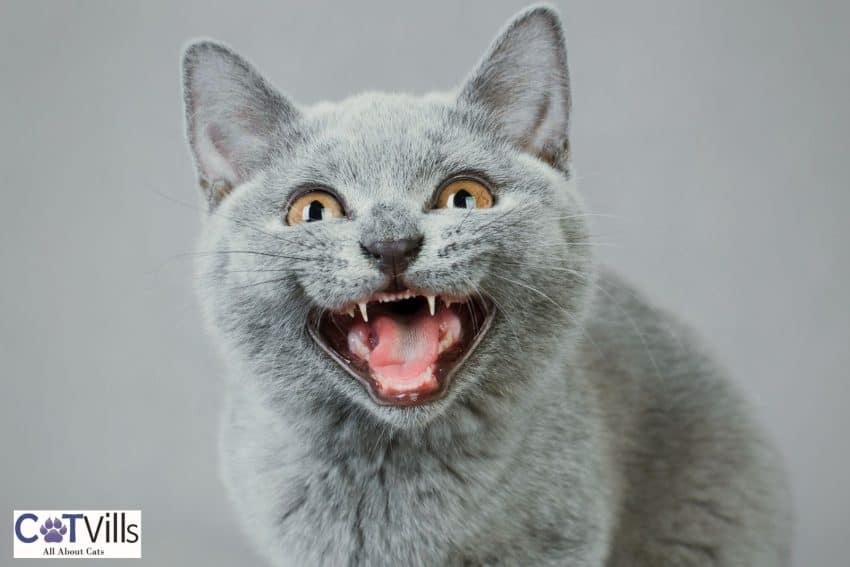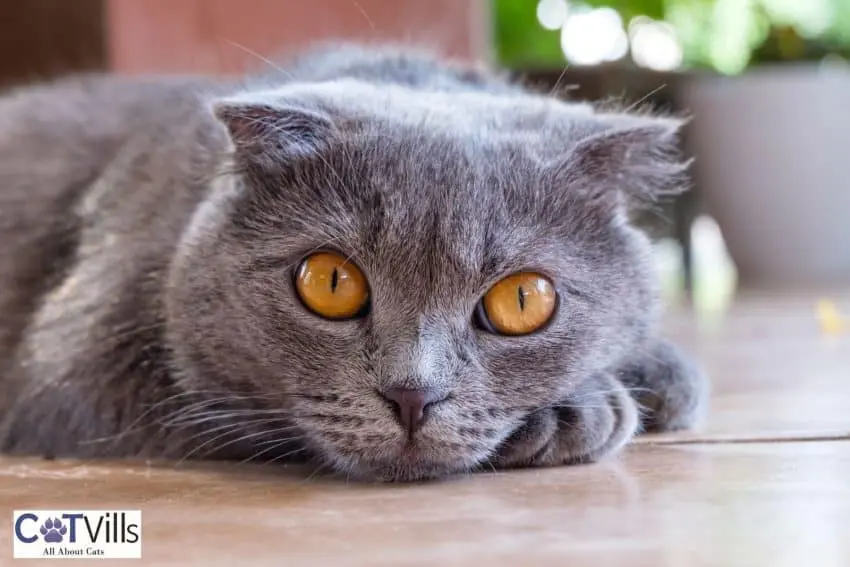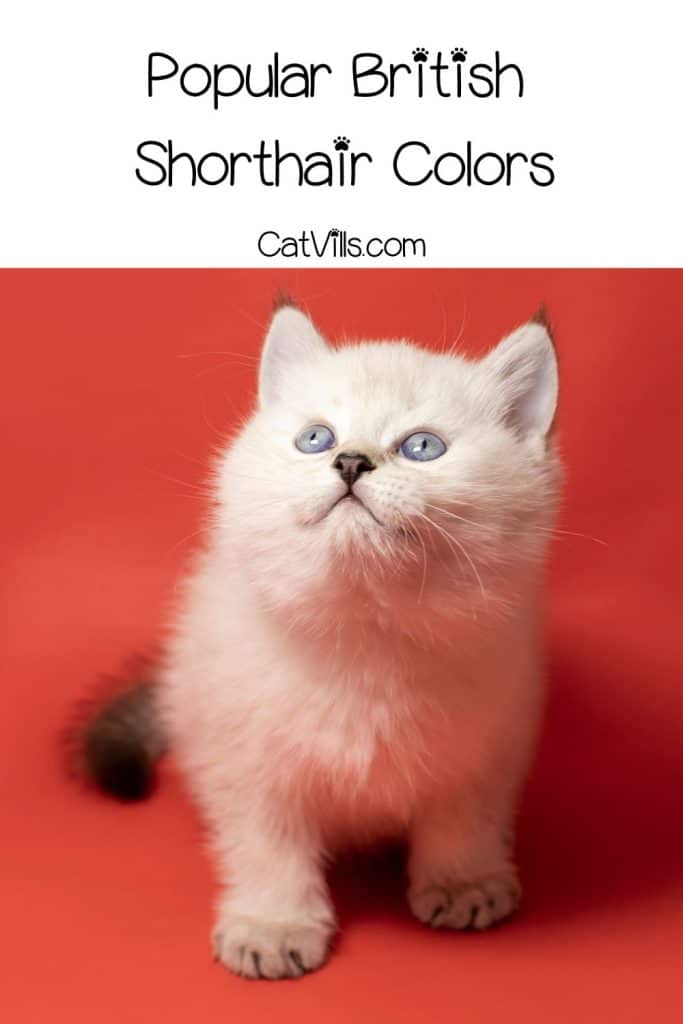Last Updated: 2 years ago
Are you wondering about British Shorthair colors?
Since British Shorthairs are excellent pets, it’s natural to wonder what colors and patterns you can choose from.
So, I will talk about all the possible British Shorthair colors and how to recognize them.
Just keep reading.
What Colors Do British Shorthair Cats Come In?
Unlike other cat breeds, British Shorthair cats come in various colors and patterns.
The combinations are too many to enumerate, so we will discuss the most popular ones.
Monochrome British Shorthair Colors
A monochrome or solid color means that the Shorthair has a dense coat of a single color without any stripes, spots, or other markings.
The single color is evenly distributed through the cat’s body. But the undercoat can be a lighter color than the overcoat.
1. Blue
Blue is the most common color for the British Shorthair. As you can see from this video, the coat is blue-gray, and the eyes are stunningly coppery orange.
Interestingly, the British Blue has blue noses and blue paw pads. They shouldn’t have tabby markings, and the breed standard doesn’t allow white hair.
Some British Bue kittens can be born with “ghost” stripes. As this cat owner shares, “They should start to fade again when the adult coat comes in fully.”
2. Lilac
Lilac British cats have a coat combining grey, pink, and blue. The lilac color shade can vary from warm pink to cold lavender.
The eyes are piercing orange-yellow, while the paw pads and nose leather correspond to the lilac shade.
3. White
The white coat should be pure in color and untipped (no yellow points). The eyes are blue, gold, copper, or odd-colored, while the paws and nose are pink.
4. Black
British Shorthairs make stunning black cats, but they’re rare.
The jet-black color is evenly distributed throughout the entire coat without white hairs or rusty tinges. The eyes are gold or copper, while the paws and nose color should be black.
5. Red/Gold
As you can see from this video, British Reds have a stunning red coat with no white hair, brick red noses, and red paw pads.
Unlike other solid colors, Red British Shorthairs have some tabby markings because the color results from crossing with other breeds.
6. Cream
Cream British cats look like watered-down red cats. The coat should be rich in color without any whites or heavy tabby patterns. Unfortunately, cream colors are rare.
7. Chocolate
Chocolate describes cats with a solid brown coat. These brown British Shorthair cats’ coats can be different shades of chocolate – from milk to dark chocolate.
Some breeders also call Chocolate British Cats – “Havana” since this coat color resembles Havana’s cat breed.
8. Cinnamon
Cinnamon cats have a warm reddish-brown coat similar in color to the spice they’re named after or diluted chocolate. Their noses and paws should be pink.
Since the color gene is recessive, producing cinnamon-colored British cats is rare.
9. Fawn
Fawn describes a warm, mushroom-like coat—soft cream with pink hues. It’s one of the hardest colors to produce, and you need to confirm it with a cat DNA test.
Tortie British Shorthair Colors
Tortoiseshell describes cats with solid colors and tabby markings. Their coat pattern resembles a mosaic pattern or a tortoise’s shell.
Almost all tortie British cats are female because this combination of colors is related to the X chromosome. Tortie male cats are 1 in 3000 and are usually sterile.
The eyes should be orange, copper, or amber.
1. Black Tortoiseshell (Black+Red)
These cats have coats of evenly colored, proportional black and red spots. Paws and muzzles should have both colors.
2. Chocolate Tortoiseshell (Chocolate+Red)
It combines chocolate (saturated) and red (bright and intense) in proportion. Both colors are present on the paws and head.
3. Blue Tortoiseshell (Blue +Cream)
This Tortie color is a combination of blue and cream spotted patterns. No tabby markings or white hair should appear.
4. Cinnamon Tortoiseshell (Cinnamon +Red)
They have a coat of evenly distributed red and cinnamon specks with no tabby markings. The Cinnamon Tortie’s muzzle and the paw pads should have red spots. It’s a very rare and valued color.
5. Lilac Tortoiseshell (Lilac+Cream)
Lilac Tortie coat combines lilac and cream in even proportions throughout their bodies with no whites or tabby patterns.
6. Fawn Tortoiseshell (Fawn+Cream)
Fawn Tortie cats have fawn and cream-colored coats. Again, the color should be evenly distributed, and no markings present.
Other Tortie Colors
Besides these colors, other possible color combinations include:
- Smoke – classic British Shorthair colors and smoke markings
- Torbie – classic colors and tabby body markings
Tabby British Shorthair Colors
Tabby-colored British shorthair cats should have dense color and well-defined marks. You can also see the letter “M” on their forehead.
1. Classic Tabbies
You can distinguish the classical tabby pattern by its butterfly markings on the shoulders, evenly ringed tail, the unbroken rings on the chest/neck, and the swirls on the cheeks.
2. Mackerel Tabbies
A mackerel British Shorthair tabby has numerous narrow stripes resembling a mini tiger. One central stipe runs unbroken along the cat’s spine.
3. Spotted Tabbies
Spotted tabbies have distinctive oblong, rosette, or round spots. The tail is ringed or spotted, while the tip of the tail is the same color as the markings.
4. Ticked Tabbies
Ticking refers to stripes of color down the length of the hair shaft – two or three bands of color on each hair. Ticked tabbies can be any color, from blue to brown to fawn.
Common Tabby Colors
Not surprisingly, British Shorthair tabby cats come in a variety of colors; among them:
- Black silver tabby – Pale silver coat with dense black markings
- Silver pathed tabby – Silver coat, dense black markings with patches of red on the body and paws
- Chocolate silver tabby – Pale silvery chocolate coat with chocolate markings
- Lilac silver tabby – Pale lilac with lilac markings
- Red tabby – Rich red markings with red color
- Brown British Shorthair tabby – Dense black markings with coppery brown color, the legs are black from the paw to the heel.
- Brown patched tabby – Brown color with red spots and dense black markings.
- Blue tabby – Deep blue markings contrasting with the pale ivory color of the coat, rose paw pads, and nose leather.
- Blue patched tabby – Patches of cream with deep blue markings
- Cream tabby – Pale cream coat color and contrasted markings
- Lilac tabby – A cool beige coat with lilac markings
Tipped British Shorthair Colors
Tipping refers to British Shorthair cats with silver coats and dark-colored ends of hair. The tipping should be even throughout the body and free of tabby markings.
1. Self-Colored
Self-color-tipped cats can have coats with black tipping, blue tipping, chocolate tipping, lilac tipping, red tipping, and cream tipping.
Tortie cats can also be tipped, in which case both colors should be present with a pale silver undercoat. Paw pads and nose leather are in appropriate colors for the tipping.
2. Shaded
Shaded British cats are silver or golden:
- Silver-shaded felines have an almost pale white body with tipped ends of the hairs.
- Golden shades kitties have a light-cream body with black/dark-tipped hair ends.
3. Chinchilla
Chinchilla cats can be silver (pure white undercoat with tipped overcoat on the head, back, flanks, and tail) or golden ( light apricot undercoat with black-tipped overcoat).
4. Cameo
Shell cameo cats have a white undercoat and lightly tipped overcoat with red tippings. Shaded cameo cats have a white undercoat and shades of red on the face, tail, and sides.
Color Points
Color-pointed British Shorthair cat has points of color that contrast with their body color. (3) Its face, ears, legs, and tails are darker in color than the rest of the body, like a Siamese.
Color-pointed cats can be self-pointed (single color with points), tortie pointed, tabby pointed, smoke pointed, golden pointed, and more.
Usually, the eye color is blue, while the paw pad corresponds to the coat color.
Colors Mixed with White
Besides all these patterns and combinations, British Shorthair cats also come in various colors mixed with white.
1. Tabby and White
Red, blue, cream, silver, and brown British Shorthair tabby cats with white. The tabby pattern should correspond to the standard but white is allowed on the legs, chest, muzzle, and feet.
2. Van Tabby and White
White British Shorthair cats with colored heads, tails, and legs.
3. Calico
Calico cats are tri-colored – white, black, and red/cream.
4. Bi-Colored
Any of the following combinations – blue and white, black and white, red and white, cream and white.
What Is the Best Color for British Shorthair: Does It Impact the Health?

It’s easy to get overwhelmed with so many British Shorthair colors. And many people believe that specific cat colors determine character and personality.
For example, British Shorthair orange cats are said to be playful, mischievous, and affectionate, while British Shorthair brown cats can be reserved and aloof.
But color doesn’t play as much role as socialization in determining how your British kitty will behave.
British Shorthair History

The British Shorthair cat (BSH) is native to England and likely one of the oldest breeds in the world, its history dating back to the first century AD.
Ancient Roman texts mention big grey cats with round yellow eyes – likely the predecessors of the modern British Shorthair cats.
So, the origin breed goes back to these domestic shorthaired cats that Roman soldiers brought to Britain when they invaded it. These shorthaired cats mixed with the local wildlife cat population.
That’s how the stocky, well-muscular British Shorthairs we know today appeared. And its appearance hasn’t changed that much since then.
Initially, BSHs were the only pedigree cats in cat exhibitions and shows in Victorian times. And in the early 1910s, breeders crossed British Shorthairs with Persons to introduce the long-haired gene.
Nowadays, the British Shorthair remains one of the most popular cat breeds in the world, gaining many admirers with its unique coloring and calm temperament.
Size
British Shorthair cats range in size from 8 to 17 pounds with a length of 22 to 25 inches (without the tail). Usually, males are bigger than females and can reach up to 20 pounds.
The body is robust and compact with short-medium legs, a massive round head, a broad medium nose, a firm chin, and medium-sized ears. Eye color and coat color varies.
You can expect your BSH to reach full physical maturity until they’re 3-5 years old.
Lifespan
British Shorthair cats are a healthy breed, and you can expect them to live up to 17 years. However, some felines can suffer from heart disease, hemophilia B, and gingivitis.
To ensure you have a healthy cat, always adopt your kitty from a licensed breeder who tests for everyday health problems.
Health
As I already said, British Shorthair cats are healthy and have few health issues, no matter their coat color. However, white British Shorthair cats with blue eyes may be deaf.
As researchers say, “upwards of 65 to 85 percent of all-white cats with both eyes blue are deaf.” So, it’s something to keep in mind if you adopt a white British Shorthair with blue eyes.
Deaf cats can lead normal lives, but you can’t let them go outside, and they’ll need some special care.
Temperament

These stocky cats are calm, easy-going, and moderately active, no matter the color of their bodies.
The British Shorthair personality makes them excellent companions for families or busy people since they don’t make a fuss when you leave them alone.
Moreover, this blue cat is a quiet cat breed, only meowing once in a while to remind you to fill the food bowl or pay attention to them.
But don’t expect a cat that doesn’t cause any problems. The British cat has a goofy side and needs a rich environment to thrive.
And do British Shorthair cats scratch furniture? Yes, they do.
Grooming
Like most short haired cat breeds, the British cat’s short coat is easy to groom and maintain. These muscular cats rarely need a bath, but you should brush their teeth weekly and trim their nails.
FAQs
WHAT IS THE RAREST COLOR OF BRITISH SHORTHAIR?
Fawn and cinnamon British Shorthair cats are the rarest British Shorthair colors.
ARE GOLDEN BRITISH SHORTHAIRS RARE?
Yes, Golden British Shorthairs are rare because it’s challenging to produce this particular shade.
ARE BRITISH SHORTHAIR CATS EXPENSIVE?
Yes, British Shorthair cats are expensive, especially if you want a more exotic color, such as fawn, cinnamon, golden, or chocolate.
Conclusion
British Shorthair cats are stunning, no matter their coat color or pattern. And they make excellent pets for owners who want a calm cat breed.
However, not all cat organizations accept all British Shorthair colors. For example, the Cat Fanciers’ Organization doesn’t accept chocolate, lavender, cinnamon, fawn, and color pointed cats.
If you think about registering or competing with your BSH kitty, keep that in mind.
What do you think about these popular British Shorthair colors? Which one is your favorite? Share your thoughts in the comment section.
Resources:

